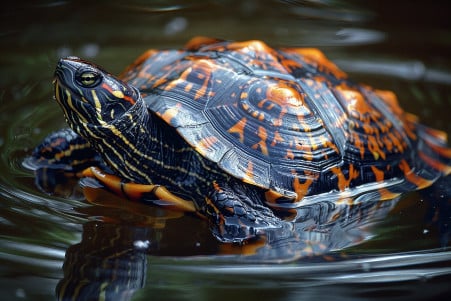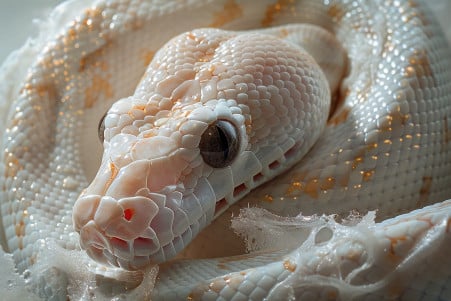Do Turtles Shed Their Shells? Exploring Turtle Molting Habits
17 April 2024 • Updated 17 April 2024

If you own a pet turtle, you may have noticed that it periodically sheds pieces of its shell or skin, but do turtles molt like other reptiles? The answer is yes, turtles shed their skin and shells in a process known as ecdysis or molting. Turtles shed the outer layer of their scutes (shell segments) and skin to accommodate their growth. This process occurs at regular intervals throughout a turtle's life, enabling them to grow while replacing old or damaged shell and skin.
To help you better understand this natural occurrence, we'll take a look at the scientific studies that have been done on turtle molting and the biology behind it. By examining research in veterinary medicine, evolutionary biology, and studies of turtles in the wild and in captivity, we'll explain why turtles molt, how often they do it, and what a normal versus abnormal molt looks like. This information will help pet owners and others who care for turtles understand the patterns of molting so they can create the best conditions for their turtles to grow and develop healthy shells.
Do turtles shed their shells?
The Science of Turtle Shell Shedding
The science behind how turtles shed their shells is a pretty cool process. A turtle's shell is made up of about 60 bones that are covered by a thin layer of epithelium tissue. This tissue is responsible for constantly creating the hard, plate-like scutes that make up the outer layer of the shell.
As the turtle grows, new, larger scutes are created beneath the existing ones, which slowly increases the diameter of the shell to accommodate the turtle's growth. Eventually, the old, smaller scutes are shed to reveal the new layer underneath in a process called ecdysis or molting.
In addition to shedding their scutes, turtles also shed the skin on their legs, neck, and other exposed areas as they outgrow it. This shedding process is important for two reasons - it allows the turtle to grow and replace old, damaged skin and shell to prevent infections.
For aquatic turtles, in particular, shedding their scutes once a year is especially important. This process removes algae from their shells and prevents the shells from getting too heavy, which could impact the turtle's ability to swim.
How Often Do Turtles Shed and What Affects Shedding?
The frequency of a turtle's shedding can depend on a variety of factors, including the species, age, and environment. All Turtles explains that aquatic turtles shed their scutes (shell plates) about once a year. This regular shedding ensures that the turtle's shell remains light enough to avoid impeding its swimming and prevent too much algae from growing on it.
That said, shedding isn't the same for every turtle. The Petco guide on aquatic turtle shedding points out that the frequency of shedding can depend on the turtle's age and species. Younger turtles may shed more often due to their rapid growth, while older turtles may shed less often.
The right environmental conditions are also important for ensuring that a turtle can shed properly. VCA Animal Hospitals explains that good water quality, temperature, lighting, and nutrition are all important for ensuring that a turtle's shedding isn't delayed or disrupted. On the other hand, stress, illness, or poor living conditions can cause a turtle to have trouble shedding.
Knowing what affects how often a turtle sheds and what can disrupt the shedding process can help you make sure that you're creating the best possible living environment for your turtle. If you take these factors into account, you can help ensure that your turtle will be able to shed regularly and healthily.
How to Tell the Difference Between Healthy and Abnormal Shedding
When a turtle is shedding normally, it will shed its skin in small pieces, which will look like a whitish, fuzzy substance in the water, according to VCA Animal Hospitals. The scutes, or shell plates, should flake off over time as the turtle grows, and there should be no raw or bleeding spots on the shell.
That said, The Spruce Pets explains that if there is excessive algal growth penetrating the shell surface or full-thickness shedding that exposes raw skin, these can be signs of a problem. Other signs of abnormal shedding, which is also called dysecdysis, include retained scutes, incomplete shedding, or shedding that results in open wounds.
As All Turtles explains, it's important to recognize these signs of abnormal shedding because they can be indicative of issues like infections, vitamin deficiencies, or environmental factors that are disrupting the turtle's natural molting cycle. By knowing how to tell the difference between normal and abnormal shedding, turtle owners can make sure to address any problems that arise and ensure their turtle gets the care it needs.
How to Help Turtles With Shedding
Never try to remove a turtle's scutes, as this can be painful and cause infections, says All Turtles. It's important to make sure that the water quality, temperature, and lighting in a turtle's habitat are all at the right levels to support healthy shedding. In addition, VCA Animal Hospitals notes that a well-rounded diet that includes the right vitamins and minerals can help prevent nutritional imbalances that can interfere with shedding.
If you notice that your turtle is experiencing any kind of abnormal shedding, like retained scutes, incomplete shedding, or shedding that results in open wounds, All Turtles says you should consult a veterinarian. A vet can help you determine the cause of the problem and recommend treatments or changes to the turtle's environment that will help them shed normally.
By making sure that you're doing everything you can to support your turtle's health and that you're providing the right environment, you can help make sure that your turtle will shed regularly and healthily, which will help them grow and thrive.
How to Treat Shell Rot and Other Shedding-Related Problems
Shell rot is a common issue that can arise from an incomplete or disrupted shedding cycle. Vet Tails explains that the first step in treating shell rot is to remove any dead shell tissue. The shell is then soaked in a diluted betadine solution, scrubbed with a brush to remove any debris, and rinsed with water. This process may need to be repeated multiple times for severe cases.
Antibiotics, both topical and systemic, are often needed to treat severe shell rot or other infections. Vet Tails suggests using silver sulfazadine cream as a topical antibiotic and ceftazadine as an injectable antibiotic for systemic treatment. In addition, proper nutrition, UVB lighting, and maintaining the turtle's body temperature are important to help the turtle heal and avoid future problems.
VCA Animal Hospitals point out that excessive algal growth that has penetrated the shell surface can also indicate an underlying issue that may need to be treated by a veterinarian. It's important to make sure that any shedding-related issues are treated thoroughly and quickly to ensure the long-term health and happiness of pet turtles.
Conclusion: How to Help Your Turtle Shed
Shedding is a normal and important part of a turtle's life cycle, especially when it comes to growth and shell health. Making sure you provide the right environmental conditions, nutrition, and care is key to ensuring that your turtle can shed normally and regularly.
By learning to recognize the signs of abnormal shedding and addressing the issues that cause it, you can help ensure that your turtle stays healthy. Understanding the factors that influence when and how turtles shed will help you create the right conditions for healthy shell development and growth.


